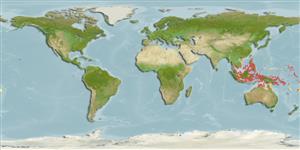Common names from other countries
Klassifizierung / Names
Namen | Synonyme | Catalog of Fishes(Gattung, Arten) | ITIS | CoL | WoRMS | Cloffa
>
Kurtiformes (Nurseryfishes, cardinalfishes.) >
Apogonidae (Cardinalfishes) > Apogoninae
Etymology: nanus: Name from Latin 'nanus' meaning dwarf, referring to its size being one of the smallest in the genus..
More on authors: Allen, Kuiter & Randall.
Environment: milieu / climate zone / depth range / distribution range
Ökologie
seewasser riff-verbunden; tiefenbereich 3 - 20 m (Ref. 48635). Tropical
Western Central Pacific: Madang, Papua New Guinea; Maumere, Indonesia; and, near Kota Kinabalu, Sabah, Malaysia.
Size / Gewicht / Alter
Maturity: Lm ? range ? - ? cm
Max length : 6.0 cm SL Männchen/unbestimmt; (Ref. 48635)
Kurzbeschreibung
Bestimmungsschlüssel | Morphologie | Morphometrie
Rückenflossenstacheln (insgesamt) : 7; Rückenflossenweichstrahlen (insgesamt) : 9; Afterflossenstacheln: 2; Afterflossenweichstrahlen: 8; Wirbelzahl: 24. This species is distinguished by having D VI-I,9; A II,8; pectoral rays 13; lateral line scales 24; predorsal scales 5; gill rakers 7 or 8+20 or 21, excluding an indistinct rudiment on upper limb; preopercular margin serrate; preopercular ridge smooth; body depth 3.4-3.7 in SL; semi-transparent in life with golden-brown midlateral strip, bordered below by narrow silver stripe; tip of lower jaw blackish (Ref. 11893).
Occurs in silty inshore reefs; aggregations observed hovering during the day around both soft and hard coral formations. An oral brooding male collected at Madang, papua New Guinea, contained 328 eggs, which is a relatively low number for the genus (Ref. 11893).
Life cycle and mating behavior
Maturities | Fortpflanzung | Spawnings | Egg(s) | Fecundities | Larven
Mouthbrooders (Ref. 240). Distinct pairing during courtship and spawning (Ref. 205).
Allen, G.R., R.H. Kuiter and J.E. Randall, 1994. Descriptions of five new species of cardinalfishes (Apogonidae: Apogon) from Maumere Bay, Flores, Indonesia and surrounding regions. Rev. Fr. Aquariol. 21(1-2):27-38. (Ref. 11893)
IUCN Rote Liste Status (Ref. 130435)
CITES (Ref. 128078)
Not Evaluated
Bedrohung für Menschen
Harmless
Nutzung durch Menschen
Tools
Can't connect to MySQL database fbquizv2. Errorcode: Too many connections
